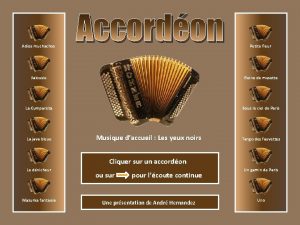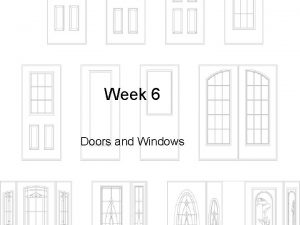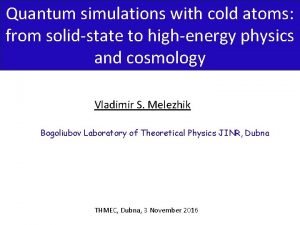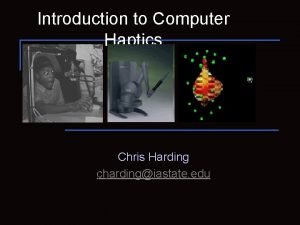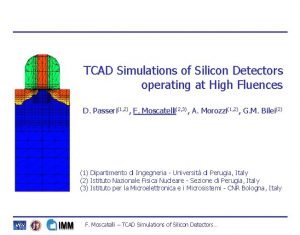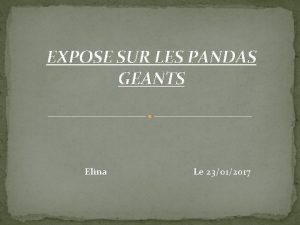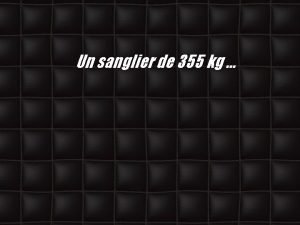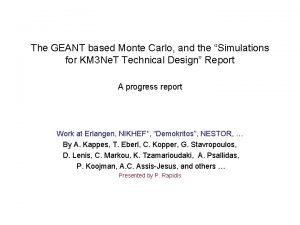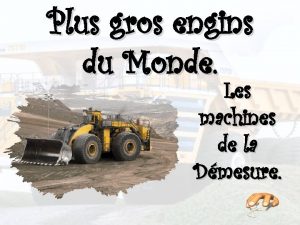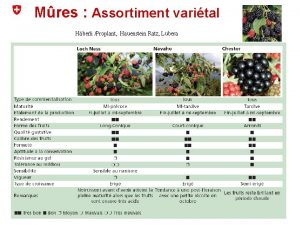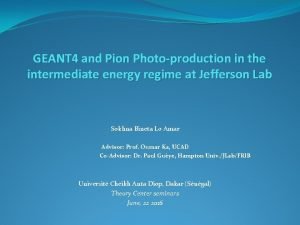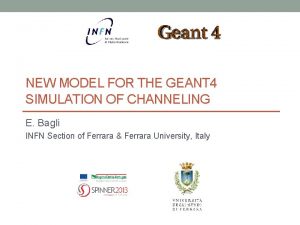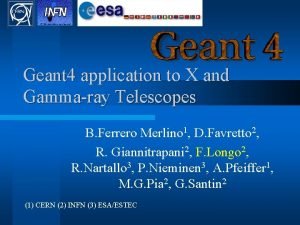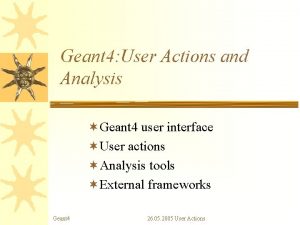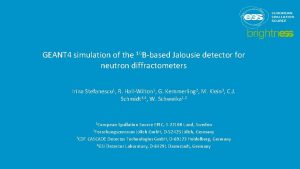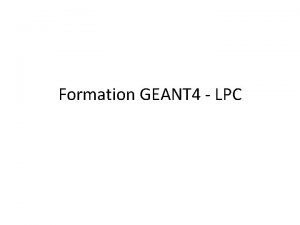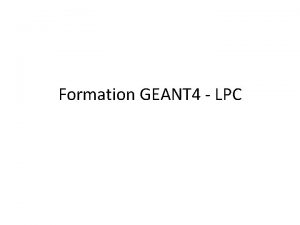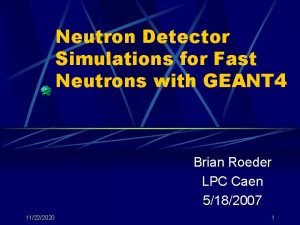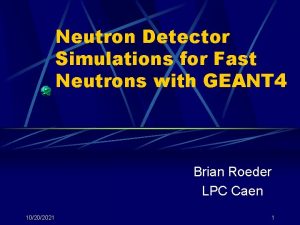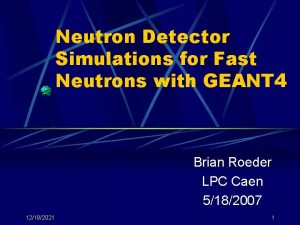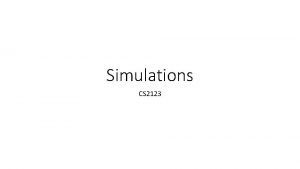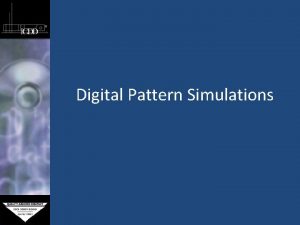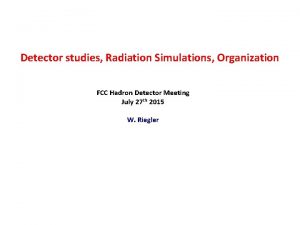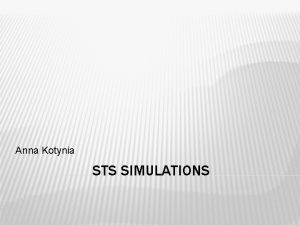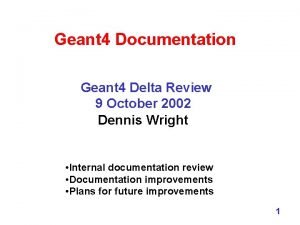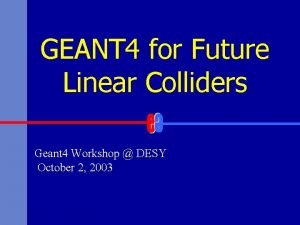GEANT 4 simulations for the Jalousie detector for
























- Slides: 24

GEANT 4 simulations for the Jalousie detector for the ESS thermal powder diffractometer HEIMDAL Irina Stefanescu, Richard Hall-Wilton ESS Detector Group www. europeanspallationsource. se

Powder diffraction with neutrons Ø HEIMDAL will operate at ESS as thermal powder diffractometer Ø Design goal: high flexibility in choosing between the high-resolution and high-intensity modes of operations. Bragg peaks at d= λ /(2∙ sin 2θ)

Powder diffraction with neutrons Ø HEIMDAL will operate at ESS as thermal powder diffractometer Ø Design goal: high flexibility in choosing between the high-resolution and high-intensity modes of operations. Δd The resolution function contains terms from the moderator, slits, sample, detectors. Bragg peaks at d= λ /(2∙ sin 2θ) State-of-the-art detectors (3 He-tubes, WISH@ISIS): horizontal pixel size ∼ 8 mm, sample –detector distance ∼ 2 m

The Jalousie detector technology Jalousie segment = 2 independent MWPC in a common housing and sharing a segmented cathode (side view) Individual segment shielding n Sensitive area (view from above) neutron beam segmented cathode, constant Δθ wires e cathod nted Segme 3 D sensitive cells = voxels Cathode strips

Baseline design for the HEIMDAL detector* sample neutron incidence angle = 10° *Technical specifications on the baseline design for the HEIMDAL detector taken from the documents submitted by the instrument 5 team for the Tollgate 2 project review (2017).

Baseline design for the HEIMDAL detector* sample neutron beam Generic Jalousie: 4 Boron layers/segment neutron incidence angle = 10° *Technical specifications on the baseline design for the HEIMDAL detector taken from the documents submitted by the instrument 6 team for the Tollgate 2 project review (2017).

Baseline design for the HEIMDAL detector* sample neutron beam neutron incidence angle = 10° *Technical specifications on the baseline design for the HEIMDAL detector taken from the documents submitted by the instrument 7 team for the Tollgate 2 project review (2017).

Baseline design for the HEIMDAL detector* Wire pitch ~ 16. 8 mm FWHM ~ wire pitch * tan(10°) ~ 2. 1 mm sample w m. 8 m 6 1 10 B 4 C ~9. 6 mm n ~ 7 mm HEIMDAL detector voxel neutron incidence angle = 10° Δtofdetector ~ 8 μs @ 1. 8 Å For HEIMDAL Δtofpulse ~ 130 μs or higher in high-resolution mode small effect of the detector depth on the resolution function is expected *Technical specifications on the baseline design for the HEIMDAL detector taken from the documents submitted by the instrument 8 team for the Tollgate 2 project review (2017).

The GEANT 4 Jalousie detector model for HEIMDAL Crucial to have a model that is able to simulate realistically the spatial resolution of the detector build the sensitive area as a collection of Ar-CO 2 gas voxels that resemble closely the readout voxels. m . 8 m 16 10 B voxeli+1 4 C w ~ 7 mm o n + 10 B 7 Li + α ~ 9. 6 mm HEIMDAL gas voxel o o voxeli o n voxeli = interaction voxel with the coordinates of the center xci, yci, zci Use coordinates of the centre of the interaction voxel to calculate the flight path of the detected neutron λ, d HEIMDAL detector segment in GEANT 4 Analysis with ROOT. 9

Validation of the simulation strategy • Compared the results of the GEANT 4 model for the prototype of the Jalousie segment for POWTEX* with the experimental results obtained in scans with collimated beam. strips Experimental FWHM =7. 85 mm • wires FWHM = 12. 8 mm Calculated efficiency also matches the experimental value. GEANT 4 POWTEX: powder diffraction instrument under construction at FRM 2 (Garching b. Munich). Experimental data from G. Modzel, Ph. D thesis, Univ. of Heidelberg, 2014, and M. Henske et al. , NIMA 686(2012) 151. FWHM = 8. 1 mm GEANT 4 FWHM = 12. 5 mm 10

Calculated position resolution for the baseline design of the HEIMDAL detector Wire 5 ……… Wire 1 Wire 2 Wire 3 Wire 4 Collimated beam FWHM = 2. 3 mm Good agreement with the expectations baseline design for the detector close to the optimal one 11

Investigation of the detector contribution to the instrumental resolution function As the HEIMDAL instrument is still in design phase, a complete virtual instrument model is not available yet. Neutron trajectories required for this study generated with the VITESS model of a generic diffraction instrument (WISH-like) and a sample with a well-known crystallographic structure (Na 2 Ca 3 Al 2 F 14). ISIS TS 2 Moderator n Lms ~ 41 m NAC sample Slit Write neutron trajectories in a file. �� 12

Investigation of the detector contribution to the instrumental resolution function As the HEIMDAL instrument is still in design phase, a complete virtual instrument model is not available yet. Neutron trajectories required for this study generated with the VITESS model of a generic diffraction instrument (WISH-like) and a sample with a well-known crystallographic structure (Na 2 Ca 3 Al 2 F 14). ISIS TS 2 Moderator n Lms ~ 41 m NAC sample GEANT 4 model for the WISHlike detector Slit Write neutron trajectories in a file. �� GEANT 4 model for the HEIMDAL detector 13

Investigation of the detector contribution to the resolution function WISH-like detector (position sensitive 3 He tubes) WISH, experimental NAC sample GEANT 4 � Details of the engineering design for the support and assembly of the detectors, collimators and sample environments are not included in the model. � �� The detector is a low background source HEIMDAL-Jalousie detector GEANT 4

Investigation of the detector contribution to the resolution function WISH, experimental NAC sample Fit with a Gauss + Exp WISH-like detector (position sensitive 3 He tubes) GEANT 4 2θ ≈ 90° § Details of the engineering design for the support and assembly of the detectors, collimators and sample environments, which could have some relevance for the background from the scattered neutrons not included in the model. The detector is a low background source HEIMDAL-Jalousie detector GEANT 4

Study of the detector contribution to the resolution function ☜ Data normalized to this point 1. 2 Δd/d, normalized 1 0. 8 0. 6 0. 4 HEIMDAL 0. 2 WISH-like 2θ ≈ 90° 0 0 1 2 3 4 5 6 d-spacing (Å) The baseline design for the HEIMDAL-Jalousie detector gives better separated Bragg peaks than the gold standard He-3 position-sensitive tube 16

Conclusions and perspectives Ø The results of this study prove that the baseline design for the HEIMDAL detector has an advantage over the state-of-the-art 3 He position-sensitive tubes. Ø For the HEIMDAL instrument, the larger depth of the detector voxel does not affect the resolution function as the uncertainty in the time-of-flight introduced by it is much smaller than the length of the pulse from the PS choppers running in high-resolution mode. Ø Waiting for the virtual instrument model to become available repeat this study plus other studies such as detector design optimization, detailed investigation of the scattered background in the detector, etc. Ø The Jalousie detector is the baseline technology for the single-crystal diffractometer (MAGIC) and the bispectral powder diffractometer DREAM at the European Spallation Source. The technical specifications of the MAGIC-Jalousie detector are very similar to HEIMDAL-Jalousie, therefore most of the results obtained in this study apply to the MAGIC detector. Work funded by Grant# 676548 17

Rietveld refinement method for angular– and wavelength-dispersive TOF powder diffraction data Novel approach for Rietveld refinement by using 2 D powder diffraction data recorded with the largearea detectors expected to be the standard data analysis method. P. Jacobs, A. Houben, W. Schweika, A. L. Tchougréeff, R. Dronskowski, Journal of Applied Crystallography, 48, 1627 (2015). GEANT 4, HEIMDAL detector 1 D-diffraction pattern of the NAC sample GEANT 4, HEIMDAL detector Δλ 2 D-diffraction pattern of the NAC sample 18

19

The Jalousie detector technology n Jalousie detector for the POWTEX NPD (FRM 2) DREAM-Jalousie detector n The ESS diffraction instruments (so the detectors) are still in design phase. Technical specifications for the instruments (and detectors) still subject to optimisations. n MAGIC-Jalousie detector HEIMDAL-Jalousie detector

Calculated position resolution for the HEIMDAL detector w 1 w 2 w 3 w 4 wi wi 2θc x Collimated beam Δ 2θFWHM = 0. 15° FWHM = 2. 27 mm 21

Δ 2θ binning with Jalousie POWTEX, DREAM: Δ 2θ binning determined by the strip width x HEIMDAL, MAGIC: Δ 2θ binning determined by the segment width 2θc x Δ 2θ HEIMDAL, 2 side coating Counts DREAM, Δ 2θ = 0. 28° POWTEX, Δ 2θ = 0. 47° 22

Δ 2θ binning with Jalousie POWTEX, DREAM: Δ 2θ binning determined by the width of the cathode strip x HEIMDAL, MAGIC: Δ 2θ binning determined by the segment width 2θc x Δ 2θ DREAM, Δ 2θ = 0. 28° HEIMDAL, 1 -side coating Counts Δ 2θ = 0. 15° (FWHM) POWTEX, Δ 2θ = 0. 47° 23

Simulations of the contribution of the detector to the resolution function tof (ms) Moderator n Sample Slit 24 tof (ms)
 La fleur jalousie
La fleur jalousie La jalousie est une preuve d'amour
La jalousie est une preuve d'amour Jalousie door
Jalousie door Awning window symbol
Awning window symbol World history simulations
World history simulations Baton simulations
Baton simulations Clinical simulations in nursing education
Clinical simulations in nursing education Simulations for solid state physics
Simulations for solid state physics Chris harding simulations
Chris harding simulations Www.irs.gov/app/understanding taxes/student/simulations.jsp
Www.irs.gov/app/understanding taxes/student/simulations.jsp Tcad simulations
Tcad simulations Ippd key tenets
Ippd key tenets Yes or no
Yes or no Exposé sur le panda géant
Exposé sur le panda géant Sanglier attila 355 kg
Sanglier attila 355 kg Gate geant
Gate geant Geant simulation
Geant simulation Geant 4
Geant 4 La plus grosse pelle mécanique au monde
La plus grosse pelle mécanique au monde Myrtillier géant
Myrtillier géant Pion geant
Pion geant Geant 4
Geant 4 Geant 4
Geant 4 Action geant
Action geant Renmap
Renmap
